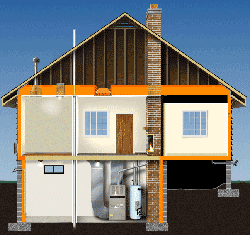Insulation
Heat flows naturally from warmer to cooler areas. To maintain comfort, heat lost during the winter must be replaced by the heating system, and heat gained during the summer months must be removed by the air conditioning system.
-
Why Should You Insulate Your Home?

By slowing and trapping air, insulation acts as a barrier to keep home temperatures more constant.
Up to 70 percent of energy spent in the average American home is used on heating and cooling (space conditioning). Insulation makes your home more comfortable, and also saves money.By slowing and trapping air, insulation acts as a barrier to keep home temperatures more constant. Heat is "trapped" in air pockets between the fibers of the insulation. The thickness and type of insulation affect the amount of heat that enters your home.
-
Installing Insulation
Insulation is available in a variety of forms, such as batting, blankets, rigid foam board, spray foam, blown-in blanket, and loose-fill. Each type is designed to fit a particular part of your house.
The easiest and most cost-effective way to insulate your home is to add insulation in the attic. To find out if you have enough insulation, measure the thickness of the insulation. If there is less that 6 - 7 inches (R-22), you could benefit from adding more.
Insulation is measured in R-values. The higher the R-value, the better the heat retention of the insulation over time. The R-value is dependent on the type and thickness of the material you select. The ZIP-Code Insulation Program can help you find the recommended R-value for insulating your home in your area.
Additional Resources
- EnergyStar
- Oak Ridge National Laboratory
- Office of Energy Efficiency and Renewable Energy | U.S. Department of Energy



